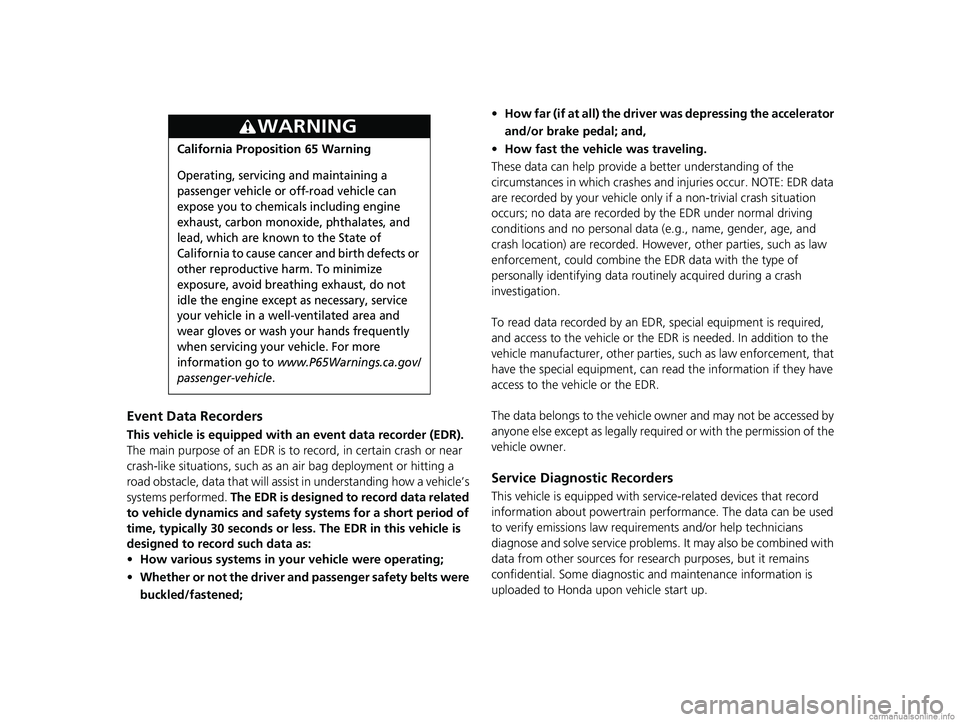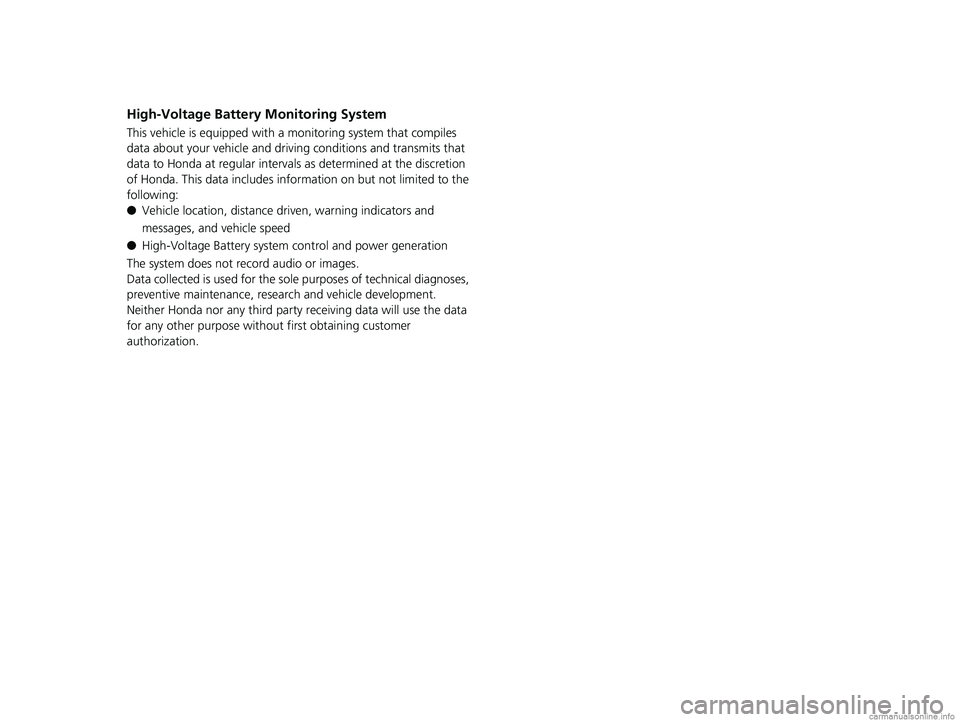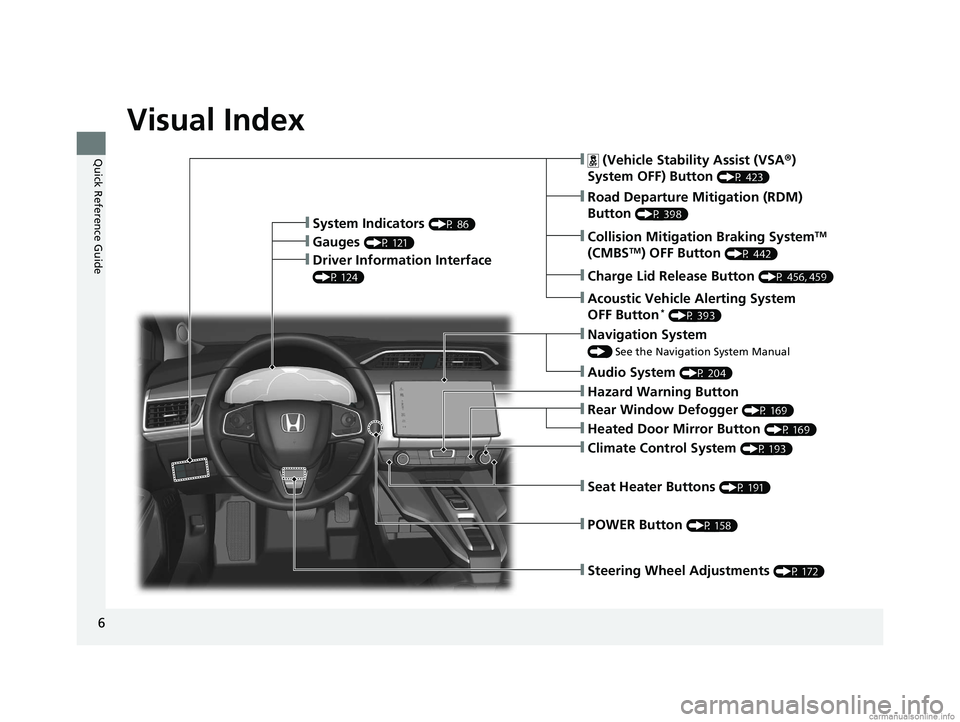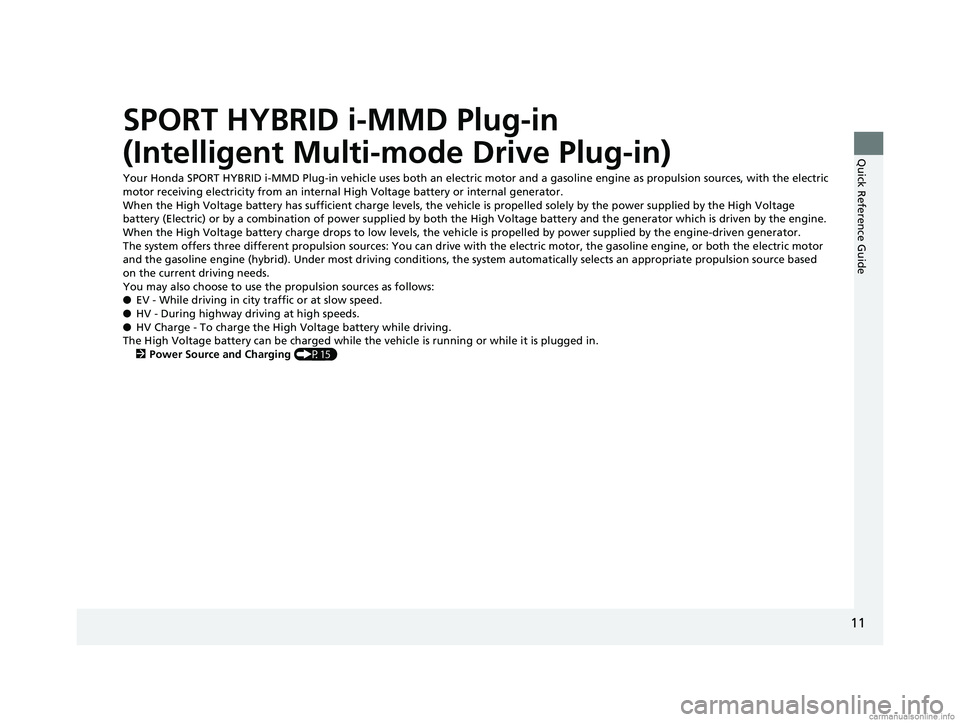2018 HONDA CLARITY PLUG-IN power system
[x] Cancel search: power systemPage 2 of 591

Event Data Recorders
This vehicle is equipped with an event data recorder (EDR).
The main purpose of an EDR is to record, in certain crash or near
crash-like situations, such as an air bag deployment or hitting a
road obstacle, data that will assi st in understanding how a vehicle’s
systems performed. The EDR is designed to record data related
to vehicle dynamics and safety systems for a short period of
time, typically 30 seconds or le ss. The EDR in this vehicle is
designed to record such data as:
• How various systems in your vehicle were operating;
• Whether or not the driver and passenger safety belts were
buckled/fastened;
3WARNING
California Proposition 65 Warning
Operating, servicing and maintaining a
passenger vehicle or off-road vehicle can
expose you to chemicals including engine
exhaust, carbon monoxide, phthalates, and
lead, which are known to the State of
California to cause cancer and birth defects or
other reproductive harm. To minimize
exposure, avoid breathing exhaust, do not
idle the engine except as necessary, service
your vehicle in a well-ventilated area and
wear gloves or wash your hands frequently
when servicing your vehicle. For more
information go to
www.P65Warnings.ca.gov/
passenger-vehicle
.
• How far (if at all) the driver was depressing the accelerator
and/or brake pedal; and,
• How fast the vehicle was traveling.
These data can help provide a better understanding of the
circumstances in which crashes and injuries occur. NOTE: EDR data
are recorded by your vehicle only if a non-trivial crash situation
occurs; no data are recorded by the EDR under normal driving
conditions and no personal data (e.g., name, gender, age, and
crash location) are recorded. Howeve r, other parties, such as law
enforcement, could co mbine the EDR data with the type of
personally identifying data routinely acquired during a crash
investigation.
To read data recorded by an ED R, special equipment is required,
and access to the vehicle or the EDR is needed. In addition to the
vehicle manufacturer, other parties, such as law enforcement, that
have the special equipment, can re ad the information if they have
access to the vehicle or the EDR.
The data belongs to the vehicle ow ner and may not be accessed by
anyone else except as legally requ ired or with the permission of the
vehicle owner.
Service Diagnostic Recorders
This vehicle is equipped with serv ice-related devices that record
information about powertrain perform ance. The data can be used
to verify emissions law requirem ents and/or help technicians
diagnose and solve service problems. It may also be combined with
data from other sources for res earch purposes, but it remains
confidential. Some diagnostic and maintenance information is
uploaded to Honda upon vehicle start up.
18 CLARITY PHEV CSS-31TRW6000.book 0 ページ 2017年12月25日 月曜日 午後2時22分
Page 4 of 591

High-Voltage Battery Monitoring System
This vehicle is equipped with a monitoring system that compiles
data about your vehicle and driving conditions and transmits that
data to Honda at regular intervals as determined at the discretion
of Honda. This data includes information on but not limited to the
following:
● Vehicle location, distance driven, warning indicators and
messages, and vehicle speed
● High-Voltage Battery system control and power generation
The system does not record audio or images.
Data collected is used for the sole purposes of technical diagnoses,
preventive maintenance, resear ch and vehicle development.
Neither Honda nor any third party receiving data will use the data
for any other purpose without first obtaining customer
authorization.
18 CLARITY PHEV CSS-31TRW6000.book 2 ページ 2017年12月25日 月曜日 午後2時22分
Page 7 of 591

Contents
Child Safety P. 69Safety Labels P. 83
Opening and Closing the Trunk P. 150 Security System P. 153 Opening and Closing the Windows P. 156
Adjusting the Mirrors P. 173 Adjusting the Seats P. 175
Climate Control System P. 193
Audio Error Messages P. 284 General Information on the Audio System P. 288
Bluetooth ® HandsFreeLink ® P. 335
When Driving P. 376 Braking P. 431Parking Your Vehicle P. 447
Charging P. 454 Fuel Economy and CO
2 Emissions P. 469
Maintenance Under the Hood P. 480 Replacing Light Bulbs P. 494
Checking and Maintaining Tires P. 499 12-Volt Battery P. 508 Remote Transmitter Care P. 510
Accessories and Modifications P. 519
Power System Won’t Start P. 535 Jump Starting P. 539 Overheating P. 542
Fuses P. 553 Emergency Towing P. 561
When You Cannot Open the Charge Lid P. 563 When You Cannot Open the Trunk P. 564
Devices that Emit Radio Waves P. 569 Reporting Safety Defects P. 571
Authorized Manuals P. 576 Customer Service Information P. 577
Quick Reference GuideP. 6
Safe DrivingP. 41
Instrument PanelP. 85
ControlsP. 135
FeaturesP. 203
DrivingP. 369
MaintenanceP. 471
Handling the UnexpectedP. 521
InformationP. 565
IndexP. 579
18 CLARITY PHEV CSS-31TRW6000.book 7 ページ 2017年12月25日 月曜日 午後2時22分
Page 8 of 591

6
Quick Reference Guide
Quick Reference Guide
Visual Index
❙Steering Wheel Adjustments (P 172)
❙ (Vehicle Stability Assist (VSA®)
System OFF) Button
(P 423)
❙Road Departure Mitigation (RDM)
Button
(P 398)❙System Indicators (P 86)
❙Gauges (P 121)❙Collision Mitigation Braking SystemTM
(CMBSTM) OFF Button (P 442)❙Driver Information Interface
(P 124)
❙Navigation System
() See the Navigation System Manual
❙Audio System (P 204)
❙Hazard Warning Button
❙Climate Control System (P 193)
❙Rear Window Defogger (P 169)
❙POWER Button (P 158)
❙Seat Heater Buttons (P 191)
❙Heated Door Mirror Button (P 169)
❙Acoustic Vehicle Alerting System
OFF Button* (P 393)
❙Charge Lid Release Button (P 456, 459)
18 CLARITY PHEV CSS-31TRW6000.book 6 ページ 2017年12月25日 月曜日 午後2時22分
Page 13 of 591

11
Quick Reference Guide
SPORT HYBRID i-MMD Plug-in
(Intelligent Multi-mode Drive Plug-in)
Your Honda SPORT HYBRID i-MMD Plug-in vehicle uses both an electric motor and a gasoline engine as propulsion sources, with the electric
motor receiving electricity from an internal High Voltage battery or internal generator.
When the High Voltage battery has sufficient charge levels, the vehicle is propelled solely by the power supplied by the High V oltage
battery (Electric) or by a combination of power supplied by both the High Voltage battery and the generator which is driven by the engine.
When the High Voltage battery charge drops to low levels, the ve hicle is propelled by power supplied by the engine-driven generator.
The system offers three different propulsion sources: You can drive with the electric motor, th e gasoline engine, or both the electric motor
and the gasoline engine (hybrid). Under most driving conditions , the system automatically selects an appropriate propulsion source based
on the current driving needs.
You may also choose to use the propulsion sources as follows:
● EV - While driving in city traffic or at slow speed.
● HV - During highway driving at high speeds.
● HV Charge - To charge the High Voltage battery while driving.
The High Voltage battery can be charged while the vehicle is running or while it is plugged in.
2 Power Source and Charging (P15)
18 CLARITY PHEV CSS-31TRW6000.book 11 ページ 2017年12月25日 月曜日 午後2時22分
Page 15 of 591

13
Quick Reference Guide
Auto Engine Stop/Start
The car will select the appropriate source of power depending on the drive mode you select.
As a result, the engine will automatically start or stop as needed to either charge the battery or provide supplemental power.
Under certain circumstances, the engine may turn on or, if it is already on, it may not turn off.
● You are going uphill or accelerating aggressively.
● The climate control system is in heavy use.
● The Ambient temperature is too hot or too cold.
● The High Voltage Battery state of charge is very low.
● The vehicle is running a system check.
System Check
When the engine initially starts (between the time the POWER button is turned on and turned of f), the vehicle conducts a system check.
● While the check is being conducted, the engine may periodically turn on and off. This, however, is normal.
● The curved blue line in the POWER/CHARGE Gauge will not appear during the system check ( EV indicator may still turn on).
● Once the engine starts, it will continue to run until the system reaches operating temperature.
The curved blue line in the POWER/CHARGE Gauge will reappear once the system check is completed.
2 POWER/CHARGE Gauge (P122)
18 CLARITY PHEV CSS-31TRW6000.book 13 ページ 2017年12月25日 月曜日 午後2時22分
Page 19 of 591

17
Quick Reference Guide
HV Charge
To enable HV Charge, press the HV button until the HV Charge indicator turns on.
While the vehicle is in HV Charge, the High Voltage battery will continue to charge until the battery charge level display reac hes 12
segments. Once the battery reaches this leve l, the vehicle switches to HV. You can cancel HV Charge before the battery reaches 12 segments
by pressing the HV button.
When the vehicle is in HV Charge, priority is given to the charging of the High Voltage battery. While the battery is being charged, the
engine may run at a higher RPM than usual. The time it takes for the battery to be charged to 12 segments varies depending on d riving
conditions.
The high voltage battery can be charged to 12 segments in after about 1 hour of high-speed driving. HV Charge is not recommende d for
city driving or other driving situations when you need to stop frequently or driv e slowly. In these situations, press the HV button again to
disable HV Charge. If you are in HV and approaching a destination where the vehicle can be charged, you can turn off HV and use the
remaining battery power to drive.
Time
High Voltage battery when charged to 12 segments
HV
Charge
Remaining power of the
High Voltage battery
Press and hold
the
HV button.Press the HV button.
EV EV
HV
u
Any time the HV button is pressed
while in HV or HV Charge, the
system returns to EV operation.
18 CLARITY PHEV CSS-31TRW6000.book 17 ページ 2017年12月25日 月曜日 午後2時22分
Page 20 of 591

18
Quick Reference Guide
Energy Efficiency
As with a gasoline powered vehicle, the fuel efficiency and the range of this vehicle is most impacted by the driver’s driving style. Aggressive
acceleration and high-speed driving can easily trigger the system to switch the propulsion source to the gasoline-powered engin e. Climate
control system usage also has a str ong impact with heavy usage negatively affecting the vehicle’s range.
Battery Type
There are two types of batteries used in this vehicle, a standa rd 12-volt battery that powers the airbags, the interior and exterior lights, and
other standard 12-volt systems, and a high voltage battery that is used to power the propulsion motor and recharge the 12-volt battery.
Hybrid Vehicles
High voltage parts and high voltag e wires in this vehicle are sheathed in electro magnetic shielding material; therefore, the am ount of
electromagnetic waves emitted is no more gr eater than those emitted by household appliances or the electrical parts in conventional
vehicles.
Sounds Unique to the Honda Plug-In System
When you first start driving this vehicle, you likely will hear some unfamiliar sounds, particularly when you first turn on the power system,
while driving, and just after parking. Some of these sounds are unique to this vehicle‘s powertrain, fuel, and climate control systems; others
are similar to sounds generated by conventional automobiles that typically are masked by louder noises absent from a vehicle of this design.
These sounds are not a cause for concern, and you will soon recognize them as normal and thus be able to detect any new or unus ual noise
should one develop.
After shutting off the engi ne, you may hear certain noises coming from the vehicle. Here’s the lowdown:
● Noise from Under Vehicle: This noise is caused by the vacuum pump inside the fuel evaporation leakage check module (ELCM).
Depending on conditions, the pump will come on for about 15 minutes about 5 to 10 hours after engine shutoff. This noise is just normal
vehicle operation and don’t indicate a vehicle problem.
18 CLARITY PHEV CSS-31TRW6000.book 18 ページ 2017年12月25日 月曜日 午後2時22分